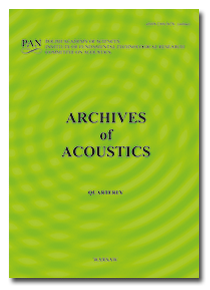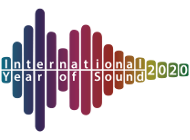Archives of Acoustics,
37, 3, pp. 269–278, 2012
Pulsed Focused Nonlinear Acoustic Fields from Clinically Relevant Therapeutic Sources in Layered Media: Experimental Data and Numerical Prediction Results
In many therapeutic applications of a pulsed focused ultrasound with various intensities the finite-
amplitude acoustic waves propagate in water before penetrating into tissues and their local heating.
Water is used as the matching, cooling and harmonics generating medium. In order to design ultrasonic
probes for various therapeutic applications based on the local tissue heating induced in selected organs
as well as to plan ultrasonic regimes of treatment a knowledge of pressure variations in pulsed focused
nonlinear acoustic beams produced in layered media is necessary. The main objective of this work was to
verify experimentally the applicability of the recently developed numerical model based on the Time-
Averaged Wave Envelope (TAWE) approach (Wójcik et al., 2006) as an effective research tool for
predicting the pulsed focused nonlinear fields produced in two-layer media comprising of water and tested
materials (with attenuation arbitrarily dependent on frequency) by clinically relevant axially-symmetric
therapeutic sources. First, the model was verified in water as a reference medium with known linear and
nonlinear acoustic properties. The measurements in water were carried out at a 25◦C temperature using
a 2.25 MHz circular focused (f/3.0) transducer with an effective diameter of 29 mm. The measurement
results obtained for 8-cycle tone bursts with three different initial pressure amplitudes varied between
37 kPa and 113 kPa were compared with the numerical predictions obtained for the source boundary
condition parameters determined experimentally. The comparison of the experimental results with those
simulated numerically has shown that the model based on the TAWE approach predicts well both the
spatial-peak and spatial-spectral pressure variations in the pulsed focused nonlinear beams produced by
the transducer used in water for all excitation levels complying with the condition corresponding to weak
or moderate source-pressure levels. Quantitative analysis of the simulated nonlinear beams from circular
transducers with ka ≫ 1 allowed to show that the axial distance at which sudden accretion of the 2nd
or higher harmonics amplitude appears is specific for this transducer regardless of the excitation level
providing weak to moderate nonlinear fields. For the transducer used, the axial distance at which the
2nd harmonics amplitude suddenly begins to grow was found to be equal to 60 mm. Then, the model
was verified experimentally for two-layer parallel media comprising of a 60-mm water layer and a 60-mm
layer of 1.3-butanediol (99%, Sigma-Aldrich Chemie GmbH, Steinheim, Germany). This medium was
selected because of its tissue-mimicking acoustic properties and known nonlinearity parameter B/A.
The measurements of both, the peak- and harmonic-pressure variations in the pulsed nonlinear acoustic
beams produced in two-layer media (water/1.3-butanediol) were performed for the same source boundary
conditions as in water. The measurement results were compared with those simulated numerically. The
good agreement between the measured data and numerical calculations has shown that the model based on
the TAWE approach is well suited to predict both the peak and harmonic pressure variations in the pulsed
focused nonlinear sound beams produced in layered media by clinically relevant therapeutic sources.
Finally, the pulsed focused nonlinear fields from the transducer used in two-layer media: water/castor
oil, water/silicone oil (Dow Corning Ltd., Coventry, UK), water/human brain and water/pig liver were
predicted for various values of the nonlinearity parameter of tested media.
amplitude acoustic waves propagate in water before penetrating into tissues and their local heating.
Water is used as the matching, cooling and harmonics generating medium. In order to design ultrasonic
probes for various therapeutic applications based on the local tissue heating induced in selected organs
as well as to plan ultrasonic regimes of treatment a knowledge of pressure variations in pulsed focused
nonlinear acoustic beams produced in layered media is necessary. The main objective of this work was to
verify experimentally the applicability of the recently developed numerical model based on the Time-
Averaged Wave Envelope (TAWE) approach (Wójcik et al., 2006) as an effective research tool for
predicting the pulsed focused nonlinear fields produced in two-layer media comprising of water and tested
materials (with attenuation arbitrarily dependent on frequency) by clinically relevant axially-symmetric
therapeutic sources. First, the model was verified in water as a reference medium with known linear and
nonlinear acoustic properties. The measurements in water were carried out at a 25◦C temperature using
a 2.25 MHz circular focused (f/3.0) transducer with an effective diameter of 29 mm. The measurement
results obtained for 8-cycle tone bursts with three different initial pressure amplitudes varied between
37 kPa and 113 kPa were compared with the numerical predictions obtained for the source boundary
condition parameters determined experimentally. The comparison of the experimental results with those
simulated numerically has shown that the model based on the TAWE approach predicts well both the
spatial-peak and spatial-spectral pressure variations in the pulsed focused nonlinear beams produced by
the transducer used in water for all excitation levels complying with the condition corresponding to weak
or moderate source-pressure levels. Quantitative analysis of the simulated nonlinear beams from circular
transducers with ka ≫ 1 allowed to show that the axial distance at which sudden accretion of the 2nd
or higher harmonics amplitude appears is specific for this transducer regardless of the excitation level
providing weak to moderate nonlinear fields. For the transducer used, the axial distance at which the
2nd harmonics amplitude suddenly begins to grow was found to be equal to 60 mm. Then, the model
was verified experimentally for two-layer parallel media comprising of a 60-mm water layer and a 60-mm
layer of 1.3-butanediol (99%, Sigma-Aldrich Chemie GmbH, Steinheim, Germany). This medium was
selected because of its tissue-mimicking acoustic properties and known nonlinearity parameter B/A.
The measurements of both, the peak- and harmonic-pressure variations in the pulsed nonlinear acoustic
beams produced in two-layer media (water/1.3-butanediol) were performed for the same source boundary
conditions as in water. The measurement results were compared with those simulated numerically. The
good agreement between the measured data and numerical calculations has shown that the model based on
the TAWE approach is well suited to predict both the peak and harmonic pressure variations in the pulsed
focused nonlinear sound beams produced in layered media by clinically relevant therapeutic sources.
Finally, the pulsed focused nonlinear fields from the transducer used in two-layer media: water/castor
oil, water/silicone oil (Dow Corning Ltd., Coventry, UK), water/human brain and water/pig liver were
predicted for various values of the nonlinearity parameter of tested media.
Keywords:
therapeutic ultrasound; circular focused transducers; pulsed nonlinear acoustic pressure beams; layered media; numerical modeling and experiments
Full Text:
PDF
Copyright © Polish Academy of Sciences & Institute of Fundamental Technological Research (IPPT PAN).





